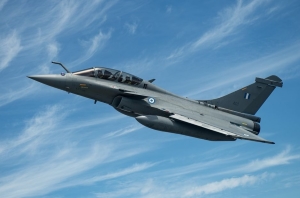Table of Equipment
Fighters
F-16C/D Block 30, 50 Fighting Falcon:

Description:
It is a single-seat, single-engine, multiple role fighter, designed for all weather operations and capable of carrying a great variety of weapon systems. Greece has in its air arsenal about 70 F-16s, BLOCK 30 and BLOCK 50. In 1989 Greece purchased 40 BLOCK 30 under the Arms Programme “Peace Xenia I” and in 1997 40 additional BLOCK 50 aircraft were delivered to Greece as part of “Peace Xenia II”. The Hellenic F-16s BLOCK 30 and BLOCK 50 are based in the air base of Larissa (110 Combat Wing, 346 Squadron “Iason”) and in the air base of New Anchialos (111 Combat Wing, 330 “Thunder”, 341 “Arrow” and 347 “Perseas” Squadrons). All the Hellenic F-16s wear the “Aegean Ghost” camouflage, which is very efficient in Aegean operational environment.
Description:
- Crew: 1 (C model), 2 (D model)
- Engine: General Electric F110-GE 100 afterburning turbofan (Block 30, 29,000 lbs thrust), General Electric F110-GE 129 (Block 50, 31,000 lbs thrust)
- Wing Span: 9.96 m
- Length: 15.06 m
- Maximum Speed: 2,120 km/h
- Service Ceiling: 15,240m or 50,000 ft
F-16C/D Block 52+ Fighting Falcon:
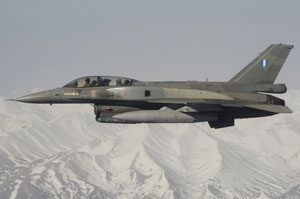
Description:
The Hellenic Air Force is the first Air Force in the world to operate this advanced F-16 type. This aircraft is the improved version of the BLOCK 50 with advanced electronics and upgraded engine. The Hellenic Air Force’s BLOCK 52+ belong to 340 and 343 Squadrons with call signs “Fox” and “Star” respectively. Both squadrons are based in Souda Air Force Base (115 Combat Wing).
Specifications:
- Crew: (C model), 2 (D model)
- Engine: 1 Pratt & Whitney F100-PW 229, 29,100 lbs thrust
- Wing Span: 9.45 m
- Length: 14.52 m
- Maximum Speed: 2,173 km/h
- Service Ceiling: 15,240m or 49,000 ft
F-16C/D Block 52+ ADV Fighting Falcon:

Description:
This aircraft is the improved version of the BLOCK 52 with advanced electronics. The Hellenic Air Force’s BLOCK 52+ Adv belong to 335 Squadron with call signs “Tiger”. The squadron base is Araxos Air Force Base (116 Combat Wing).
Specifications:
- Crew: 1(C model), 2 (D model)
- Engine: 1 Pratt & Whitney F100-PW 229, 29,100 lbs thrust
- Wing Span: 9,96 m
- Length: 15,06 m
- Maximum Speed: 2,173 km/h or 2,05 Mach
- Service Ceiling: 15,240m or 50.000 ft
Rafale F3R:
Description:
This aircraft have joined recently
Specifications:
- Crew: 1
- Engine: 2 x Snecma M88-4e turbofans
- Wing Span: 10,27 m
- Length: 15,27 m
- Maximum Speed: 750 kt CAS ή 1,6 Mach
- Service Ceiling: 15,240m or 50.000 ft
Mirage 2000 EGM/BGM:
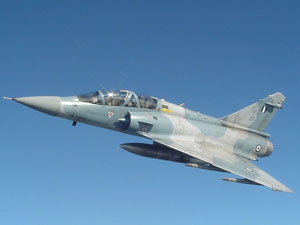
Description:
Mirage 2000 is a French single seat, single-engine, delta wing, multiple role fighter, capable of all weather operations. Mirage 2000 entered service with the HAF in 1988, when 40 aircraft were controversially purchased under the “Talos” contract. It is capable of carrying a large variety of modern weapon systems. The Hellenic Mirage 2000s are predominantly used as interceptors and against enemy ships as they are compatible with the EXOCET missile. They operate from the 331 and 332 Squadrons, with call signs “Thiseas” and “Geraki” respectively, which are based in 114 Combat Wing in Tanagra air base. The Hellenic Mirage 2000s wear blue and gray camouflage.
Specifications:
- Crew: 1
- Engine: SNECMA M53 P2 jet engine with afterburner, 9.8 tons thrust.
- Wing Span: 9.13 m
- Length: 14.36 m
- Maximum Speed: 2.2 Mach
- Service Ceiling: 50,000 ft
Mirage 2000-5:
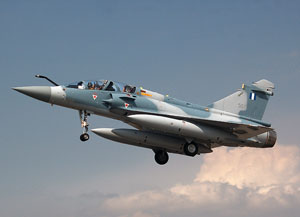
Description:
Fifteen of the total twenty-five M2000-5 aircraft were obtained by France, while the remaining ten belonged to the Hellenic Air Force and were upgraded by the Hellenic Aerospace Industry. The upgrade included the replace of the total electronic equipment and the weapons, turning M2000-5 into some of the most qualified aircraft.
Differences between M2000 and M2000-5
- RADAR: Τhe Μ2000 is equipped with the RDM radar, while the Μ2000-5 has the more advanced RDY-2.
- DATA PROCESING: The Μ2000 is equipped with two main computers (MC1 & MC2) as oposed to the Μ2000-5’s modular data processing unit (MDPU)
- INS (Inertial Navigation System): The Μ2000 has the mechanical ULISS system, while the Μ2000-5 has the TOTEM 3000 laser gyro.
- COCPIT: Μ2000 has analogue cockpit while the Μ2000-5 has a glass cockpit.
- ICMS (Countermeasures System): Μ2000-5 has the advanced type system ΜΚ3
Specifications:
- Crew: 1
- Engine: by pass turbofan SNECMA M53 P2 jet engine with afterburner/ thrust: 9.8 tn
- Wing Span: 9.13 m
- Lenght: 14.36 m
- Maximum Speed: 2.2 Mach
- Service Ceiling: 50.000 ft
F-4E Phantom II:

Description:
It is a two-seat, twin-engine, multiple role fighter, predominantly used for interception and reconnaissance missions (RF-4E). It is yet another US airplane and production deliveries for the USAF began in November 1963. US F-4s were tested in battle in the Arab-Israeli conflicts of 1973 and 1982 as well as in the Vietnam War and suffered heavy casualties as dozens of them were downed by Soviet SAM (Surface to Air Missiles).
The Phantom entered service with the HAF in 1974 under the arms programme “Peace Icarus”. Although it is a second-generation aircraft, 36 Hellenic Phantoms have been upgraded with advanced electronics (programme “Peace Icarus 2000”), extending their operational life. They are based in Andrabida air base (117 Combat Wing, 338 and 339 Squadrons with call signs “Aris” and “Aias” respectively) and in Larissa air base (110 Combat Wing, 337 and 348 Squadrons “Ghost” and “Eyes” respectively). After the upgrade programme, all the Hellenic F-4Es wear the “Aegean Ghost” camouflage while all The Hellenic RF-4Es wear the “Vietnam” camouflage.
Specifications:
- Crew: 2
- Engine: 2 General Electric J-79 turbojet engines with afterburners, 17,900 lbs.
- Wing Span: 11.7 m
- Length: 19.1 m
- Maximum Speed: 2,2 Mach
- Service Ceiling: 50,000 ft
RF-4E Phantom:

Description:
The RF-4E is a variation of the F-4E. The main difference is the photo cameras at the nose, with lateral and rear observation capabilities. The RF-4E has the can carry 4 different types of cameras, with the LOROP KS-127A as most impressive, which can take photos from a height of 35,000 ft. Another option is the AAD-5 infrared system which can be used day and night. The Greek RF-4Es are fitted with weapons and self-defense systems and are capable to operate from up to an altitude of 40,000 ft, depending on the mission. Their main role is reconnaissance before and after an air attack. They are based in Larissa, at 110 Combat Wing, and they operate from the 348 Squadron with call sign “Eyes”.
Specifications:
- Crew: 2
- Engine: 2 General Electric J-79-GE-15 turbojet engines with afterburners, thrust 17,900 lbs.
- Wing Span: 11.7 m
- Length: 19.1 m
- Maximum Speed: 2,370 km/h or 2.23 Mach
- Service Ceiling: 50,000 ft
Support
C-130H Hercules

Description:
The C-130 is a four-engine cargo airplane, which is capable of executing various missions. It is one of the most important US aircraft and it is in service in about 40 countries due to its resilience and reliability. The Hellenic C-130s carry out the majority of the air transportations in Greece and are also deployed in humanitarian and fire fighting missions. The C-130 has been in service in the Hellenic Air Force for many years (since1975). Hellenic C-130s belong to the 356 Squadron “Hercules”, which is based in Elefsis airport (112 Combat Wing). They wear the four-color “Vietnam” camouflage.
Specifications:
- Crew: 5
- Engine: C-130B Allison T-56-A7, C-130H Allison T-56-A-15, 4,058 hp.
- Wing Span: 40.4 m
- Length: 29.8 m
- Maximum Speed: 621 km/hour
- Service Ceiling (loaded): 7.000m or 23,000 ft
- Service Ceiling (empty): 10.000m or 33,000 ft
C-27J Spartan

Description:
12 airplanes have been bought and most of them have already been delivered. The C-27s is operating from the 354 Squadron “Pigasos”, which stopped its operations in late 1970s. The legendary Noratlas airplanes, which carried out the “Niki” mission in Cyprus in July 1974, a few days after the Turkish invasion, belonged to 354 Squadron. The Hellenic C-27J Spartans wear a single-colour gray camouflage.
Specifications:
- Crew: 3
- Engine: 2 Rolls Royce AE 2100D2 turboprops
- Wing Span: 28.70 m
- Length: 22.70 m
- Maximum Speed: 602 km/hour
- Service Ceiling: 9.150m or 30.000 ft
Erieye EMB-145H AEW&C

Description:
The Erieye EMB-145H AEW&C is an airborne Command and Control Platform (Command & Control – C2) with the capability of participation in air and surface operations.
Hellenic Air Force has four (4) aircrafts that belong to 380 AEW&C SQN. (Airborne Early Warning & Control).
The EMB-145H AEW&C can perform the following missions:
- Creation of Recognized Air and Surface Picture (RASP).
- Data exchange (via DATA LINK & VOICE) with Air Defence and naval units.
- Control fighters and Support to joint mixed operations.
- Support to emission control procedures (Emission Control – EMCON).
- Collection and reduction of Electronic Intelligence (ELINT).
- C/SAR support.
Specifications:
- Crew: 7 (2 Flight Crew και 5 Mission Crew).
- Platform Constructor: EMBRAER.
- Mission System Constructors: SAAB, THALLES, Electronica SPA.
- Engines: 2 Turbofan ROLLS ROYCE, type AE3007A1P, thrust 2×8169 lb
- Span: 21 m
- Length: 30 m
- Height: 7,22 m
- Ceiling: 30000 ft
- Maximum Speed: 0.75 Mach.
Embraer EMB-135

Description:
VIP Passenger Aircraft. The Hellenic Air Force operates two types . The EMB-135LR with a 35 passenger capacity and the EMB-135BJ LEGACY with a 15 passenger capacity
Technical Specifications EMB-135LR:
- Crew: 5 (Pilot – Copilot – Engineer – Flight Attendant)
- Manufacturer: EMBRAER
- Engines: 2 Turbofan ROLLS ROYCE, model AE3007A1P, with 2×8169 lb of thrust
- Wing Span: 20,04 m
- Length: 26,33 m
- Ceiling: 37000 ft
- Maximum Speed: 0,78 Mach
Technical Specifications EMB-135BJ LEGACY:
- Crew: 5 (Pilot – Copilot – Engineer – Flight Attendant)
- Manufacturer: EMBRAER
- Engines: 2 Turbofan ROLLS ROYCE, model BR700-710A1-10, with 2×14700 lb of thrust
- Wing Span: 21,17 m
- Length: 26,33 m
- Ceiling: 39000 ft
- Maximum Speed: 0,78 Mach
Gulfstream V:

Description:
VIP passenger aircraft
Specifications:
- Crew: 4 (pilot – copilot – engineer- flight attendant)
- Manufacturer: Gulfstream
- Engines: 2 Rolls Royce BR700-710A1-10 turbofans
- Thrust: 2×14700 lb
- Wing span: 93.45 ft
- Length: 96.4 ft
- Ceiling: 51000 ft
- Max speed: 0.88 Mach
P-3B Orion:

Description:
The Ρ-3Β Orion is a long-range, four-propellar aircraft which greately cooperates with the navy. It originates from the United States and its true purpose is to detect ships, submarines and mines. Although it was first launched in the 1960s, it still remains up until today as one of the most trustworthy aircrafts for the job. Greece received six (6) used P-3s from the United States between 1996-1997, which replaced the HU-16B Albatross.
The aircrafts are grey and they are handled and maintained by the 353 Naval Cooperation Squadron, which consists of staff from the Hellenic Air Force and Navy. The aircraft’s capabilities, including antisubmarine warfare, maritime research and monitoring and naval support, outdo those of the Albatros, which it replaced.
Its equipment consists of tactical-navy AN/ ASN-124 systems, audio processing devices, ESM and electronic self-protection systems. It is capable of transporting equipment weighing up to 10 tons, including conventional weapon loads such as the Mk 46 Mod.5 submarine torpedos and Mk 55 mines. Although the P-3B weapons and equipment systems are satisfactory to the current needs of the Hellenic Armed Forces, there are constant considerations for upgrades, based on the experience of the USN, which constantly applies new modernization standards.
Technical Characteristics/Performances:
- Staff: 8 (3 Aviators and 5 naval staff members)
- Motor: Allison T-56-A-14 with 4.910 hp power
- Wingspan: 30.37 m
- Length: 35.61 μ
- Maximum speed: 411 nodes
- Maximum height: 8. 625 m
Fire-Fighting
Canadair CL-215GR
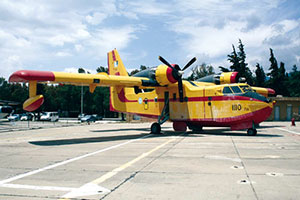
Description:
This aircraft is the successor of the Canadair CL-215. The CL-415 is predominantly deployed in firefighting tasks but also in search and rescue missions. It has significantly improved features compared to its predecessor. It has the capacity of undertaking 5,455 litres in just 12 seconds. The CL-415 is based in 112 Combat Wing, 383 Squadron “Proteas”, in Elefsis Air Force Base. They wear red and yellow camouflage.
Specifications:
- Crew: 2
- Engine: 2 PRATT AND WHITNEY PW123AF
- Wing Span: 28.60 m
- Length: 19.82 m
- Maximum Speed: 376 km/hour
Canadair CL-415

Description:
This aircraft is the successor of the Canadair CL-215. The CL-415 is predominantly deployed in firefighting tasks but also in search and rescue missions. It has significantly improved features compared to its predecessor. It has the capacity of undertaking 5,455 litres in just 12 seconds. The CL-415 is based in 113 Combat Wing, 383 Squadron “Proteas”, in Thessaloniki Air Force Base. They wear red and yellow camouflage.
Specifications:
- Crew: 2
- Engine: 2 PRATT AND WHITNEY PW123AF
- Wing Span: 28.60 m
- Length: 19.82 m
- Maximum Speed: 376 km/hour
PZL (Mielec) M-18B “Dromader”

Specifications:
- Crew: 1-2
- Manufacturer: POLSKIE ZAKLADY LOTNICZE
- Engines: Rotary Piston PZL-KALISZ model Asz-621-M18
- Power: 967 HP
- Wingspan: 17,7 m
- Length: 9,5 m
- Max Speed : 228 km/h
- Ceiling: 4000 m
- Use: Firefighting – Crop Dusting
Trainers
T-41D

Description:
The Τ-41 is a single-engine, propeller aircraft of the Hellenic Air Force for the initial training of the new pilots. It has been in service for decades now and it is used at the initial stage training of young pilots. The first aircraft were built in the mid-60s in the United States and their continuous production to this day is a testimony to their reliability. They wear red and gray camouflage.
Specifications:
- Crew: 2 (trainer and trainee)
- Engine: 1 Continental 0-360-D six-cylinder piston engine of 210 hp
- Wing Span: 10.92 m
- Length: 8.21 m
- Maximum Speed: 232 km/h
- Service Ceiling: 5.800m. or 17.000 ft
T-6A TEXAN II

Description:
The T-6 is a single-engine, U.S built, turboprop-training aircraft and it was designed to have the flight characteristics and the sense of jet aircraft. Its main characteristic is the advanced cockpit, where liquid crystal displays simulate the environment of modern fighter’s cockpits thus making the entrance to them simpler. The T-6 is considered to be one of the top training aircraft in the world in its category. It is by far the most advanced training aircraft of the Hellenic Air Force and it is based in Kalamata Air Force Base (120 Air Training Wing, 361 Squadron Basic Training Squadron “Pelops”). It wears a two-colour white and blue camouflage.
Specifications:
- Crew: 2 (trainer and trainee)
- Engine: Pratt and Whitney PT6A-68 turboprop of 1,100hp.
- Wing Span: 10.19 m
- Length: 10.16 m
- Maximum Speed: 586 km/h
- Service Ceiling: 9.500m. or 31.000 ft
T-2E Buckeye

Description:
It is a US built, twin-engine training aircraft. T-2 is the only training jet aircraft of the Hellenic Air Force and is used for the final stage of young pilots’ training. T-2s operate from Kalamata Air Force Base (120 Air Training Wing) and belong to 362 squadron “Nestor” and 363 squadron “Danaos”. The specific airplane has trained many generations of Greek pilots but despite its reliability it is expected to be replaced shortly by a new training jet. It wears a three-colour, brown, green and white camouflage.
Specifications:
- Crew: 2 (trainer and trainee)
- Engine: 2 J-85-GE-4A of 2,950 lbs each.
- Wing Span: 11.6 m
- Length: 11.8 m
- Maximum Speed: 840 km/h or 0.85 Mach
- Service Ceiling: 13.800m. or 45.200 ft
Helicopters
AS 332C1 Super Puma

Description:
The Super Puma helicopter is a common project shared between EUROCOPTER GROUP-AEROSPATIALE and DASA. It is a twin-engine, single rotor, multi-role helicopter considered ideal for combat missions, due to its great resilience, reliability and flexibility. Hellenic Super Pumas have a crucial social contribution as they are also used for search and rescue missions. It is yet another aircraft based in 112 Combat Wing, 358 Squadron, in the Air Force Base of Elefsis. They wear blue and gray camouflage.
Specifications:
- Crew: 4 (2 pilots, engineer and rescuer)
- Length: 18.70 m
- Weight: 4,370 kg (without load)
- Rotor Diameter: 15.08 m
- Maximum Speed: 277 km/hour
A-109E Power:

Description:
The A-109 is an Italian-built, multi-purpose, helicopter in service in many countries.
The helicopter is used as a flying ambulance in Greece and it is based in 112 Combat Wing, in Elefsis air base.
Specifications:
- Crew: 4 (2 pilots, doctor and nurse)
- Length: 13.06 m
- Weight: 2,850 kg
- Rotor Diameter: 11.02 m
- Maximum Speed: 305 km/hour
B-212

Description:
It is a two-engine, single-rotor, medium-transport capability, multiple-role helicopter .
It is used as a VIP carrier. They are based at 112CW in Elefsis, in 358 “Phaethon” squadron.
Specifications:
- Crew: 3 (Pilot, co-pilot and flight engineer)
- Passengers : 5
- Length: 17.41 m
- Weight: 2.695 kg (empty)
- Rotor diameter: 14,63 m
- Max speed: 185 Km/h
AB-205
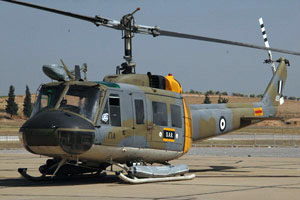
Description:
It is a single-engine, single-rotor, medium-transport capability, multiple-role helicopter .
It is used as a supply and personnel carrier, and for Search and Rescue operations. They are based at 112CW in Elefsis, in 358 “Phaethon” squadron.
Specifications:
- Crew: 3 (Pilot, co-pilot and flight engineer)
- Length: 16,50 m
- Weight: 2.495 kg (empty), 4.309 kg (operational)
- Rotor diameter: 14,71 m
- Max speed: 222 Km/h
Disclaimer
All the information is obtained from the official site of Hellenic Air Force

